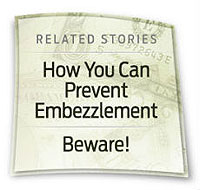
Posted October 1, 2012
A recent news headline announced: “Woman Charged With Embezzling $1 million From the [Roman Catholic] Archdiocese of New York.” Over the course of seven years the 67-year-old woman, working as a finance officer, quietly drained money from a fund established for providing education at Catholic schools. Each time the employee took amounts less than $2,500, which would have required a supervisor’s signature. External auditors originally discovered $350,000 missing, at which time police were brought in to investigate. How could this happen without detection for seven years?

Easy access to church funds can create the opportunity for an individual to defraud the organization. Examples in the Seventh-day Adventist Church include the employee or volunteer who is responsible for accounts payable, including their personal utility bills along with those of the organization, then writing a payment for the total amount due. This type of activity can go undetected for long periods of time.
Are these just rare, unfortunate incidents? Unfortunately, they are not. Trends show embezzlement and theft increasing in nonprofit and religious organizations. It merits attention even in the Seventh-day Adventist Church.
Our church operates on a trust relationship with employees and volunteers. We thank the Lord that the vast majority of these people are doing exactly what is intended: faithfully working and volunteering to fulfill the mission of the church. Unfortunately, there are those few that, for whatever reasons, feel they can help themselves to the gifts of the faithful. Complicating this is a feeling by some that placing internal controls will send a message to our workers and volunteers that we do not trust them. In reality these safeguards help honest people too. They create an environment that allows honest people to work without fear of accusations of wrongdoing.
Helping the Cause
The best intentions can sometimes lead to disaster. Imagine the excitement of a local church treasurer who received an e-mail explaining that he had been chosen to assist the sender with “freeing” millions of dollars from an account in another country. Could this be true? Was God leading him to do something special?
Certainly, if he had the kind of money described in the e-mail, he would be able to help the struggling church in many ways. He thought about it. He likely even prayed that this would be real. He responded to the message and soon found himself in the downward spiral of a scam requiring him to provide money to help fund the release of the fortune. Each step in the transaction seemed reasonable. To stop the process would require him to abandon the money he had already “invested.” He didn’t have the personal funds necessary to claim the king’s ransom that had been promised. Surely the good he could do would offset any issues or concerns if he “borrowed” some of the offerings from the local church. He would replace the church funds from the grand payoff and would donate an additional amount.
Regardless of intentions, this was embezzlement. The well-meaning church treasurer soon found himself facing a prison sentence for the theft of more than US$1 million. The local church struggled to rebound from the financial loss. The outcome was bad all the way around, except for those operating the scheme who ended up with the church’s money.
\Couldn’t happen to us? Think again. This scenario took place in a Seventh-day Adventist Church.
Protecting the Lord’s Church
Do you know your local treasurer? Are monthly financial reports provided to the governing board? Are questions concerning local finances being properly answered in a timely manner?
 In one case, failure to recognize certain warning signs (see top sidebar) led to the discovery that there was no treasurer at all! The pastor, without the church’s knowledge, was keeping the books, and hundreds of thousands of dollars had been inappropriately used.
In one case, failure to recognize certain warning signs (see top sidebar) led to the discovery that there was no treasurer at all! The pastor, without the church’s knowledge, was keeping the books, and hundreds of thousands of dollars had been inappropriately used.
The Seventh-day Adventist Church has faced a growing number of significant losses, some in excess of US$1 million. Adventist Risk Management, the General Conference institution assigned the risk management and insurance programs for the church, places coverage for losses of this nature through outside insurers. Unfortunately, in the insurance industry increased losses means increased premiums.
In addition to the losses and the challenges of working through all the insurance issues, there are large deductibles that must be paid by the involved church organization. In some parts of the world the deductible is large enough to make insurance coverage not worth taking. In the United States the deductible is $2,500.
It is important to remember that it’s not just the financial consequences but also the impact that such thefts have on the life of the church, the sense of distrust that comes into the activities, and the distraction from mission. Additionally, as in the situation of the Catholic Church loss, the media coverage for such losses tarnishes our reputations and distracts from the mission we have in the community.
It is important to take the right steps to safeguard church resources and to provide employees and volunteers with an environment that allows them to do their work in a protected culture (see bottom sidebar). Remember, we have been entrusted with a great responsibility as stewards of God’s assets. When caring for the Lord’s church, we must ensure that we follow the highest standards. One day we will be held accountable for what we have done with the resources the King has placed in our care.
“Many are the plans in a person’s heart, but it is the Lord’s purpose that prevails” (Prov. 19:21, NIV).
________________________
Robert E. Lemon is treasurer for the General Conference of Seventh-day Adventists. He serves as board chair for Adventist Risk Management, Inc. This article first appeared in the July 2012 issue of Adventist World.